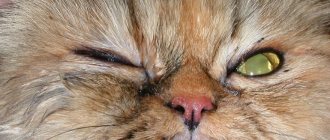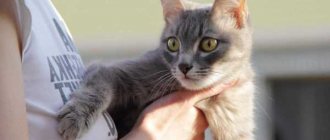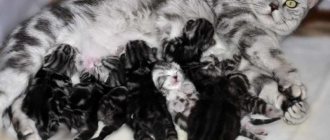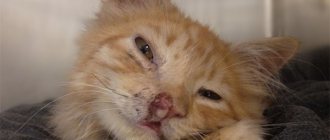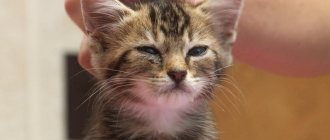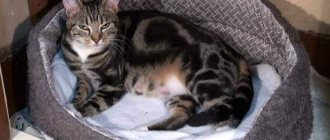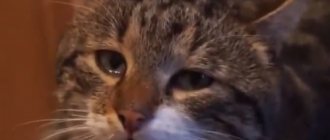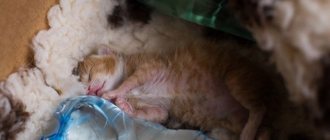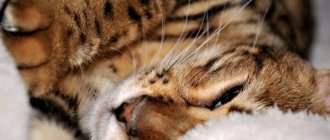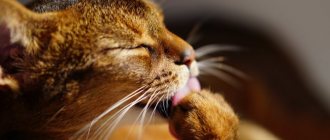(1 votes, rating: 1,00 out of 5)
5589564
08/04/2021 owner reviews
Most breeders cannot understand at the time of delivery of the pet whether the cat gave birth to all the kittens? This is necessary to avoid complications of subsequent pathological births. If the birth ends unsuccessfully, in this case the birth of all kittens, then this can lead to the death of the animal or a complete loss of reproductive function.
- How long does it take for a cat to give birth?
- How do I know when labor is over?
- Symptoms of unfinished business
- What we can do?
Can a cat not give birth to all kittens at once?
Usually, when a cat gives birth, kittens are born one at a time with an interval of 5-20 minutes.
The birth of kittens from a pet is an exciting and important event.
But due to the physiological characteristics of the animal, all the babies may not appear immediately, but after a certain time interval of several hours. Sometimes the pause lasts a day and a half, then contractions begin again, and one or two more cubs are born.
A break after the birth of a single kitten is a rare occurrence; this is a serious reason to be wary and carefully observe the behavior of the mother in labor.
The animal should be taken to a veterinary hospital if the following signs of complications appear:
- the cat does not show maternal care, is weakened, lies without changing position;
- attempts appear periodically;
- refuses to drink and eat;
- abdominal muscles are toned;
- Blood continues to leak from the vagina.
It happens that the fetuses die in the uterus, then a couple of days after birth the animal’s condition deteriorates sharply. The temperature rises, the animal experiences pain, and foul-smelling brownish-green discharge is observed from the vagina.
How long does it take for a cat to give birth?
The duration of work for representatives of the cat family depends on many individual factors. These include:
- physiological characteristics of a particular breed;
- How many times was lambing done?
- animal health;
- age of the cat;
- balance of hormones in the body;
- the conditions in which the animal is kept, its nutrition.
Most often, the normal birth of offspring in a cat lasts from 12 to 36 hours. Their duration takes into account the period of preparation, work and the birth of kittens. The kittens, in turn, come out into the world. The interval between their births can be from 30 minutes to an hour or more. There are situations where this may take several days.
© shutterstock
Cats have a physiological feature that, after the birth of a kitten, the contractions stop for a while, which allows the animal to recover and begin giving birth with renewed vigor.
How to understand how many kittens a cat has in the womb
It is impossible to visually determine how many embryos are in a cat’s belly, since the size of the abdomen is not considered an objective indicator. Its volume is affected not only by the number of fetuses, but also by amniotic fluid.
It is impossible to visually determine how many embryos are in a cat’s belly.
If the pet has one kitten in the womb, then the pregnancy may not be noticed at all.
Palpation shows the presence of fetuses in the uterus, but it is also impossible to give a specific number. In this case, intense palpation can harm the embryos and the normal course of pregnancy.
Ultrasound examination is considered a reliable diagnostic method. This is a safe way to determine the exact number of offspring. Carried out by a veterinarian in a veterinary clinic. The procedure is recommended if the cat has already had difficulties during childbirth.
Features of feline birth
Any cat owner should be aware of the nuances of their pet's reproduction and the stages of pregnancy. It is recommended to perform an ultrasound on the animal in time to ensure normal gestation and determine the number of kittens in the womb. You can find out about an approaching birth by the characteristic behavior of a cat: the expectant mother rushes around the apartment in search of a secluded place, licks her belly, and loses interest in food. Contractions begin after the mucous plug and amniotic fluid have drained. As a rule, kittens are not born immediately, but at intervals of 15-120 minutes. In some cases, the entire labor period lasts up to one and a half days. On average, a litter of a healthy and mature pet contains from 4 to 6 babies.
Yard cats, unlike their purebred counterparts, tend to be more fertile, and their births are easier. In addition, first-born cats are characterized by a small litter: no more than one or two kittens per litter.
It should be understood that during childbirth the animal is especially vulnerable, so it is necessary to notice the signs of an imminent birth in time and be near the animal at the crucial moment. Usually a woman in labor copes with her task without any problems, but in some cases she cannot do without human help. It is recommended to take the first birth under the supervision of a veterinarian.
If the fetus is in the birth canal, what to do?
Sometimes the fetus gets stuck in the birth canal due to its large size or incorrect position, sometimes difficulties arise due to lack of lubrication or insufficient strength of uterine contractions.
In this case, there is a high risk of death for him and the kittens remaining in the uterus. If a situation arises, you must immediately call a veterinarian or take the cat to a veterinary hospital.
Attention! You should not try to help the cat yourself, especially if you do not have enough experience in obstetric care. It is strictly forbidden to pull the fetus by the limbs: unprofessional actions can lead to rupture of the vagina and kill the kitten.
What to do: first aid
If you notice that the animal has apathy or other pathological symptoms, you can call a veterinarian at home to be safe from possible complications. With more frightening symptoms, such as the baby moving forward with his foot or when the cat cannot give birth for unknown reasons, you should immediately take your pet to a veterinary clinic. Before the doctor arrives, try to relieve the mother’s pain symptoms:
- Place the cat on a hard surface and massage, lightly stroke from neck to tail.
- Invite your pet to eat her favorite treat; under no circumstances force-feed her.
- Soak your cat with cool water.
Can a cat have one kitten?
Usually a cat gives birth to 3-6 or more kittens.
Usually a cat gives birth to 3-6 or more kittens, the birth of one kitten is also possible, this happens in the following cases:
- the animal is too young or the cat has reached old age and is finishing its reproductive functions;
- low quality of cat sperm due to illness or old age;
- genetic predisposition;
- death of embryos at an early stage;
- a disease of the reproductive system in a cat, which affects its fertility.
Be sure to read:
Pregnant Sphynx cat: how to find out about the position, changes in behavior and appearance, how long they walk
There is a possibility of the birth of an only kitten, but the owner should not leave everything to chance. It is possible that problems arose during childbirth, so it is necessary to carefully monitor the pet.
If you suspect that the cat cannot give birth to the remaining kittens on her own, urgent measures must be taken.
Important! Sometimes the reason for the birth of a small number of offspring should be sought in the use of hormonal drugs that prevent conception. Stress caused by frequent use of hormones negatively affects the reproduction of animals, which affects the number of babies in the litter.
Reasons: why is only one kitten born?
There is no need to worry, as the likelihood of having an only baby, especially in a young cat, is more common than it might seem. The physiological reasons why one kitten may be born are not related to health anomalies, and are most often associated with age or the course of pregnancy in the early stages. However, among the factors associated with singleton pregnancy, shortcomings in animal care often appear.
The main reasons for the birth of one kitten:
This phenomenon can be observed in older females.
- Heredity. Some breeds, for example, Persian cats, are characterized by a minimum number of kittens in the litter. Genetic predisposition also influences the offspring. This happens if several generations in a pet’s family produced only one cub.
- Age. A cat that is too young or old is more likely to give birth to one kitten. The first pregnancy in an animal, as a rule, often ends in the appearance of a single calf.
- Physical state. The formation of kittens largely depends on the resources of the mother’s body. With a lack of vitamins and poor nutrition, a cat may produce a litter only once, and an exhausted animal may not reproduce at all.
- The only egg fertilized during mating.
- Reproductive function of a cat. The health, age and fertility of the partner affect the quality and quantity of semen, and therefore the success of fertilization.
- Intrauterine processes. Not all fertilized eggs attach to the wall of the uterus, and at a later date, resorption of the fetus may occur in the cat.
Return to contents
What to do if the cat cannot give birth to the “last baby”?
When a cat has already given birth to several kittens, but there is a suspicion that not all the babies were born, urgent measures must be taken.
Attention! It is not advisable to independently check the presence of an unborn baby in a cat’s belly: it is unlikely that you will be able to feel the fetus with your fingers, but it is easy to harm it and the mother. Therefore, the only correct decision is to contact a specialist for an ultrasound.
In the absence of elevated temperature and spasms in the bronchi and heart rhythm disturbances, Oxytocin may be administered intramuscularly or into the withers to resume labor.
Sometimes the reason for the birth of small offspring should be sought in the use of hormonal drugs that prevent conception
The dosage depends on the weight of the animal, no more than 0.2-0.3 ml. If the medicine does not work, repeat the procedure after 20 minutes. If there is no result, a caesarean section can save the situation.
Important! The drug is not used if the birth canal is blocked by the fetus. The use of stimulants accelerates the separation of the placenta, which can lead to the death of the kitten and causes uterine rupture.
When should you contact a veterinarian?
As a rule, a healthy female gives birth to kittens without complications. You can guess that the birth has been successfully completed by the behavior of the mother cat: she is calm, purrs, licks her offspring, and has an appetite. After 40 minutes, the cat’s belly becomes soft, the uterus loses its tone, and no lumps can be felt. However, even a healthy cat who has given birth before can experience complications, particularly if the fetus is too large or incorrectly presented. A number of symptoms may indicate that the kitten is stuck in the birth canal and is unable to give birth on its own:
- Long (more than 40 minutes) unsuccessful attempts.
- The animal does not change its position for a long time and meows restlessly.
- Bloody discharge does not stop from the birth canal.
- Lack of interest in newborn kittens.
- Fever, increased temperature in the next day.
- Maintaining abdominal tone for more than 40 minutes, detecting other babies upon palpation.
The process of producing offspring that takes too long can be accelerated with Oxytocin.
Prolonged labor increases the risk of a dead kitten. To stimulate the process, it is recommended to inject 0.3 ml of oxytocin intramuscularly or into the withers. The use of the drug is permissible after the first baby is born. In more difficult cases, it is impossible to help the mother in labor on her own, and surgical intervention is required for resolution. It is important to notice dangerous signals in the animal’s behavior in time: untimely contacting a veterinarian is fraught with injury to the cat and offspring, and rotting of a dead fetus in the birth canal leads to intoxication and death of the mother.
Recommendations for the owner
However, complications can be prevented and their occurrence can be prevented. It is unacceptable to breed a cat that is too old. At the 7-8th year of life, the cat’s reproductive function fades away, and a possible pregnancy is fraught with complications: in old age, the risk of stillbirth and post-maturity increases. If your pet's breed is prone to dystocia (complications during childbirth), you should keep the veterinarian's phone number handy or arrange a visit with him in advance.
Is there a chance to save a kitten during a caesarean section?
The doctor cannot guarantee that unborn kittens can be saved by caesarean section. Since it is possible that the fetuses died due to hypoxia due to their prolonged stay in the uterus. The operation is more necessary for the cat itself to save its life.
Sometimes surgical intervention cannot be performed urgently due to contraindications. This is due to the fact that the operation requires stable operation of all body systems, but if the animal has a violation of cardiac and respiratory functions, it may not withstand the load and die.
Be sure to read:
Miscarriage in a cat: symptoms, reasons, what to do, why kittens are born dead
If the kittens suffocated in the womb, and the decomposition process has already begun, performing a cesarean section is pointless, since necrotic changes spread to the uterine cavity.
This requires surgery to remove the organ and ovaries, since there is a high risk of developing septic complications and death.
Is it possible to increase the number of kittens in a litter?
This question is usually of interest to breeders involved in breeding kittens for sale, since the expected profit depends on the number of offspring, as well as covering the financial resources spent on mating (treatment, testing, raising, feeding).
Depending on the regalia of the inseminating cat, the cost of mating can reach up to 10 thousand rubles. At the same time, owners of males are often not interested in the number of offspring. They receive money for mating, and the rest does not concern them. This position is fundamentally wrong: both parties should be interested in a good offspring. Before you give money for mating, ask:
- how often the cat is used;
- is he eating well? whether he has diseases of the genitourinary system;
- how many kittens are usually born from a male cat;
- Does the cat suffer from cryptorchidism?
To increase fertility, experts recommend injecting cats with the following drugs before breeding:
- Ovariovit: a homeopathic medicine that restores ovarian function, regulates the sexual cycle and increases fertility.
- Gamavit: anti-stress, immunostimulating drug, supports the vitality of the body, has a positive effect on eggs.
- Vitamin E: has a beneficial effect on the reproductive system, prevents infertility.
There is a special scheme designed for 10 days, which is often used for cats:
- Ovarium: 0.5 cc is administered subcutaneously once a day.
- Ortilin: 1 tablet twice a day.
- Ovariovit: 1 tablet 2 times a day.
- Vitamin E: 1 capsule twice a day.
- Gamavit: 1 cube per day subcutaneously.
- Catozal: 1 cube per day subcutaneously.
Treatment worsens signs of estrus and increases hormone levels. At the same time, the cat becomes more active and attractive to the inseminator.
Attention! Please consult your veterinarian before using this regimen for your cat.
Signs of the end of labor
The end of labor in a cat can be understood by the following signs:
- breathing becomes smooth and calm;
- heart rate becomes stable;
- the pet begins to actively lick the kittens, lie on its side so that it is easier for them to reach the nipples, and purrs;
- the animal needs water and food;
- an hour after the birth of the last kitten, muscle tension goes away and the belly becomes soft.
The cat leaves the nest for a short time to eat.
Correct care for a woman in labor
In the wild, cats give birth on their own, but in domestic cats, their natural instincts are muted. For this reason, it is desirable that the owner be nearby during childbirth and can provide the necessary assistance in a timely manner. It is especially needed for a cat giving birth for the first time. The pet can only guess what will be required of her. The owner’s task is to act competently and, if necessary, call a veterinarian.
Correct actions with the amniotic sac
If the bubble with the kitten inside is not damaged, if the fetus lies correctly head first, then your help will not be required. You need to intervene in the following cases: - if the bubble is torn, prepare a clean cloth, wrap it around the kitten and gently pull at the next contraction; - if the bladder is torn and the kitten is walking butt, pull without waiting for a contraction, speed is more important so that the baby does not suffocate.
If the cat does not chew the amniotic sac, this must be done for her. You will need sterile scissors. Act quickly - if you wait more than half a minute, the kitten may suffocate.
If the kittens are too big
It is difficult for a cat to give birth to large babies. It will also be difficult for you to remove the kitten; it will slip back into the vagina. If your cat's vulva is dry, lubricate it with Vaseline or lubricant. Proceed as follows: - wait for the next contraction when the baby approaches the vulva; - insert the index finger of a sterile-gloved hand into the vulva a few centimeters and move the skin towards the anus; - as soon as the kitten appears, grab it and move it slightly to help it come out. Determine the intensity of the impact yourself individually.
Veterinarians' Answers to Common Questions
A cat leaves the nest for a short time to eat
For cat owners who have not yet experienced the birth of an animal, the birth of kittens from a pet is a serious cause for concern.
After all, they do not know about the peculiarities of the course of childbirth and preparation for a responsible process. Veterinarians provide advice and answer common questions from new breeders.
How to prepare for the birth of a cat?
In order for your pet to give birth normally, it is important to provide the animal with optimal living conditions and adequate nutrition during pregnancy.
10-14 days before giving birth, you need to prepare a nest for the pet where the animal will give birth. Usually this is a box or a spacious basket, where the cat will feel comfortable and safe. The bottom is lined with several layers of flannel or fleece fabric, which you don’t mind throwing away later. You need to accustom your cat to the place in advance, otherwise she will choose a secluded corner for herself.
When the time comes for the birth of offspring, despite the fact that in 99% of cases everything goes well, it is necessary to prepare for the process a week before the expected due date. This is especially important if the cat gives birth for the first time.
What items are needed:
- clean cotton cloth and napkins;
- syringes and petroleum jelly;
- antiseptic solution (regular iodine will do);
- silk thread;
- tweezers and nail scissors;
- latex gloves;
- bandage or gauze.
Medical supplies will be needed if the cat is unable to chew the umbilical cord on its own or if it needs to be delivered.
Advice! It is recommended to stock up on the phone number of a veterinarian, who is available 24 hours a day, and a notepad to document the time of birth of the babies and the expulsion of the placentas. The data will be important if specialist help is needed.
Features of childbirth in a cat: how kittens are born
The duration of labor and the peculiarities of its course in cats are determined by the following factors:
- age;
- breed;
- state of health and hormonal system;
- conditions of keeping and nutrition of a pregnant animal.
You can determine the approach of childbirth by the behavior of your pet: she licks herself more often, hides in dark corners. Sometimes it relentlessly follows the owner, caresses him, demanding attention, or shows displeasure if he wants to pet her. Pinkish discharge is noticeable from the birth canal.
Be sure to read:
After giving birth, the cat has bleeding on the 2-3rd day, is restless, meows and breathes quickly
If a cat gives birth for the first time, and instinct does not “tell” her an algorithm of actions, the owner will have to help the kitten himself
Kittens appear after the start of pushing, move forward with their heads, sometimes with their hind legs. The fetus is enveloped by an amniotic sac, and sometimes it ruptures as it passes through the birth canal. The caring female herself frees the cub from the film and bites the umbilical cord.
Important! If a cat gives birth for the first time, and instinct does not “tell” her an algorithm of actions, the owner will have to help the kitten himself. Internet users can watch the process of cutting the umbilical cord on video.
How many times a year does a cat get pregnant?
Due to physiological characteristics, an adult cat is capable of becoming pregnant 3, even 4 times in a year, but this rate depletes the animal’s body and leads to pathological metabolic processes and changes in internal organs.
It takes 8-14 months for an animal to fully recover after childbirth and feed its offspring. Therefore, the optimal number of pregnancies per year is 1, maximum 2 times.
How long does this physiological process last?
The average duration of pregnancy is 57-71 days after mating. Childbirth occurs earlier in short-haired breeds and with multiple offspring.
Interesting! Representatives of the Scottish breed carry fetuses on average for up to 71 days, hairless sphinxes - 63, English cats - 65, large Maine Coons often live up to 68 days.
Until what age can cats give birth?
Cats are capable of giving birth before the end of estrus; for them it lasts up to 18, less often up to 20 years, but stray animals rarely live to this age.
In addition, the duration of the functions of the reproductive system after 10 years does not ensure the appearance of healthy offspring. Therefore, in older animals, the risk of giving birth to weakened kittens and with pathologies of intrauterine development increases.
Maternal instinct
If the birth went well, the cat is happy, and the kittens are healthy, there is no reason to worry. Nature has built into the pet a program for caring for the offspring, which the cat will carry out within the allotted time. No one can take care of the little ones better than the mother herself.
But it wouldn’t hurt to take care of the cat. The pet was very tired and spent a lot of energy and nerves on the difficult process of childbirth. Now she faces an equally difficult task - to produce all her offspring. A cat needs a rich, complete diet that contains as much protein as possible and all the beneficial vitamins. The pet will share all this wealth with the kittens, feeding them with milk. By 3 weeks of life, babies can already eat on their own, and they can be placed in new hands.
